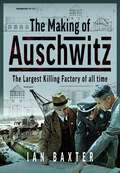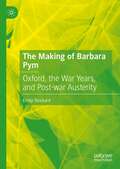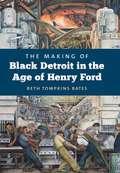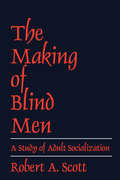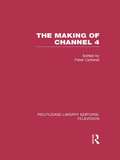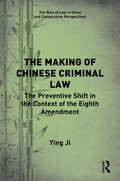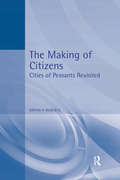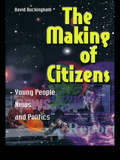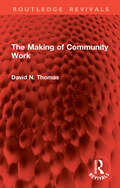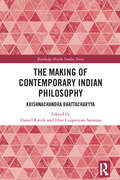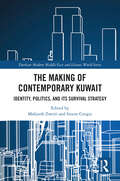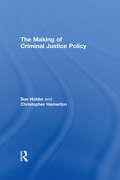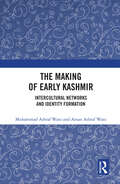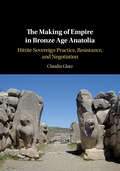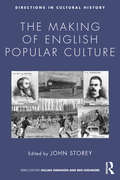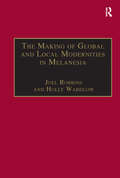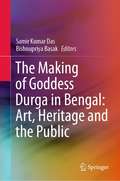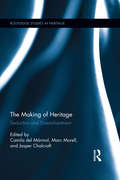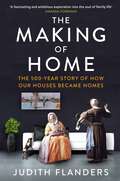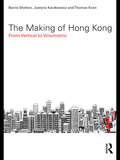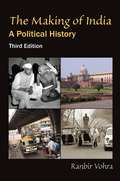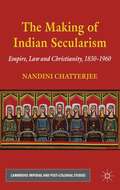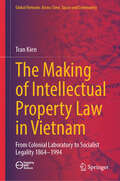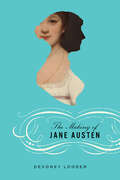- Table View
- List View
The Making of Auschwitz: The Largest Killing Factory of all time
by Ian Baxter"A chilling blueprint for genocide, The Making of Auschwitz uncovers the deadly architecture behind the largest mass murder factory in history."Commemorating 80 years since the liberation of Auschwitz-Birkenau, The Making of Auschwitz reveals the chilling construction of the largest mass murder factory in history. Drawing from hundreds of captured German documents, architectural plans, and key records from the Building Office archive, this book provides a unique historical source detailing the architectural and operational planning behind the genocide. It explores how the SS relied on civilian expertise to install crucial systems like electricity, sewage, and heating, and how external contractors eagerly participated for financial gain. From the earliest days of Birkenau's construction in 1941 to the inclusion of crematoria and gas chambers by 1943, the book traces the evolution of the camp into an industrial killing machine. Despite Himmler&’s order in 1944 to dismantle the extermination facilities, many structures remained intact when the Red Army arrived on January 27, 1945. The discovery of crucial construction blueprints, untouched by the SS&’s attempt to destroy them, offers an undeniable record of the atrocities planned and executed at Auschwitz. With rare photographs, detailed captions, and a comprehensive analysis, this book provides an essential study of those responsible for the murder of over 1 million people.
The Making of Barbara Pym: Oxford, the War Years, and Post-war Austerity
by Emily StockardThe Making of Barbara Pym offers new insights into Pym’s formative years as a writer, during which she honed a complex view of the necessity of change on individual and cultural levels. Supported by newly published archival material, this comprehensive study of Pym’s early work explores her personal and fictional pre-war and wartime writing, including unpublished and posthumously published works, before looking closely at Some Tame Gazelle and Excellent Women, published during Britain’s post-war austerity period. Of central importance is a new recognition of Pym’s use of social roles, particularly those of women, as proper avenues for change. The book traces how Pym came to devise characters whose individual development can be seen as analogous to or representative of larger cultural movements. Pym uses the spinster figure to embody the forward-looking cultural perspectives that she endorsed and then, finally, in Jane and Prudence, to figure the end of Britain’s austerity period.
The Making of Black Detroit in the Age of Henry Ford
by Beth Tompkins BatesIn the 1920s, Henry Ford hired thousands of African American men for his open-shop system of auto manufacturing. This move was a rejection of the notion that better jobs were for white men only. In The Making of Black Detroit in the Age of Henry Ford, Beth Tompkins Bates explains how black Detroiters, newly arrived from the South, seized the economic opportunities offered by Ford in the hope of gaining greater economic security. As these workers came to realize that Ford's anti-union "American Plan" did not allow them full access to the American Dream, their loyalty eroded, and they sought empowerment by pursuing a broad activist agenda. This, in turn, led them to play a pivotal role in the United Auto Workers' challenge to Ford's interests. In order to fully understand this complex shift, Bates traces allegiances among Detroit's African American community as reflected in its opposition to the Ku Klux Klan, challenges to unfair housing practices, and demands for increased and effective political participation. This groundbreaking history demonstrates how by World War II Henry Ford and his company had helped kindle the civil rights movement in Detroit without intending to do so.
The Making of Blind Men
by Robert A. ScottThe disability of blindness is a learned social role. The various attitudes and patterns of behavior that characterize people who are blind are not inherent in their condition but, rather, are acquired through ordinary processes of social learning. The Making of Blind Men is intended as a systematic and integrated overview of the blindness problem in America. Dr. Scott chronicles which aspects of this problem are being dealt with by organizations for the blind and the effectiveness of this intervention system. He details the potential consequences of blind people becoming clients of blindness agencies by pointing out that many of the attitudes, behavior patterns, and qualities of character that have been assumed to be given to blind people by their condition are, in fact, products of socialization. As the self-concepts of blind men are generated by the same processes of socialization that shape us all, Dr. Scott puts forth the challenge of reforming the organized intervention system by critically evaluating the validity of blindness workers' assumptions about blindness and the blind. It is felt that an enlightened work force can then render the socialization process of the blind into a rational and deliberate force for positive change.
The Making of Channel 4 (Routledge Library Editions: Television)
by Peter CatterallChannel 4 had been a matter of controversy for years even before it came on the air in November 1982. There were lengthy debates about what its role would be and the part to be played by the ITV companies and the growing number of independent television producers. There was also political controversy over the profile of the new channel, some wishing to see it as "their" channel in response to the apparent political hegemony of Margaret Thatcher. The result was sharp conflicts, not only over programming but, as the channel became established, over its relationships with the ITV companies and its regulatory body, the IBA. These controversies in the making of Channel 4 are revisited in this volume. The opening article by Edmund Dell, the channel's first chairman, describes and explains his sometimes stormy relationship with Jeremy Isaacs, the chief executive, while the witness seminar and the other articles offer the views of Channel 4 commissioning editors and representatives from the IBA, the ITV companies, the independent producers, the Home Office and the BBC.
The Making of Chinese Criminal Law: The Preventive Shift in the Context of the Eighth Amendment (The Rule of Law in China and Comparative Perspectives)
by Ying JiBy examining the reasons behind the preventive criminalization of Chinese criminal law, this book argues that the shift of criminal law generates popular expectations of legislative participation, and meets punitive demands of the public, but the expansion of criminal law lacks effective constraints, which will keep restricting people’s freedom in the future. The book is inspired by the eighth amendment of Chinese criminal law in 2011, which amended several penalties related to road, drug and environmental safety. It is on the eighth amendment that subsequent amendments have been based. The amendment stemmed from a series of nationally known incidents that triggered widespread public dissatisfaction with the Chinese criminal justice system. Based on John Kingdon’s theory of the multiple streams, the book explains the origins of the legislative process and its outcomes by examining the role of public opinion, policy experts and political actors in the making of Chinese criminal law. It argues that in authoritarian China, the prominence of risk control through criminal justice methods is a state response to uncertainties generated through reforms under the CCP’s leadership. The process of criminal lawmaking has become more responsive and inclusive than ever before, even though it remains a consultation with the elites within the framework set by the Chinese Communist Party (CCP), including representatives of the Lianghui, government ministries, academics and others. The process enhances the CCP’s legitimacy by not only generating popular expectations of legislative participation, but also by meeting the punitive demands of the public. The book will be of interest to academics and researchers in the areas of Chinese criminal law and comparative law.
The Making of Citizens: Cities of Peasants Revisited
by Bryan RobertsOriginally published as 'Cities of Peasants', this highly-acclaimed account of the expansion of capitalism in the developing world has now been extensively rewritten and updated.Focusing on Latin America, Bryan Roberts traces the evolution of developing societies and their economies to the present. Taking account of the move towards more 'open' economies, a shrinking of the state and various transitions towards democracies, he shows how urban growth has produced new patterns of social stratification, creating opportunities for social mobility, but doing little to decrease income inequality or political and social pressures.Underlying social changes have broadened the practice of citizenship in developing countries, limiting authoritarian rule but within a context of entrenched social inequalities and persisting political instability. This book conveys both the flavour of life in the cities of the third world and the immediacy of their problems.
The Making of Citizens: Young People, News and Politics (Media, Education and Culture)
by David BuckinghamBased on research conducted in Britain and the US, The Making of Citizens traces the dynamic complexities of young people's interpretations of news, and their judgements about the ways in which key social and political issues are represented. Rather than bemoaning young people's ignorance, he argues that we need to rethink what counts as political understanding in contemporary societies, suggesting that we need forms of factual reporting that will engage more effectively with young people's changing perceptions of themselves as citizens.The Making of Citizens provides a significant contribution to the study of media audiences and a timely intervention in contemporary debates about citizenship and political education.
The Making of Community Work (Routledge Revivals)
by David N. ThomasOriginally published in 1983, The Making of Community Work is the outcome of a two-year study of community work in the United Kingdom. The main purpose of the study was to review the development of community work, and to suggest some of the issues in practice and training that might be important in the 1980s. Much of the first part of the book is taken up with the emergence of community work as an occupation; David Thomas tries to clarify its contribution to a number of political and social processes, and to define community work in a way which distinguishes it from other kinds of interventions. The second part of the book deals with training, research, literature and employment in community work; it includes a review of college and field-based training opportunities, and a critical discussion of the state of theory and ideology in the occupation.It was hoped it would be an important source of ideas and inspiration for the years ahead. It was the first major review of community work since its re-discovery in the 1960s; it will still be of interest to all those involved in community work, or wishing to understand its influence on other professions. The book was intended for fieldworkers, administrators, policy-makers, trainers and students in community work and in related occupations and disciplines. Thomas presents his ideas clearly, and his ability to look critically at some of the basic assumptions in community work makes for stimulating and enjoyable reading.
The Making of Contemporary Indian Philosophy: Krishnachandra Bhattacharyya (Routledge Hindu Studies Series)
by Daniel Raveh Elise Coquereau-SaoumaThis book engages in a dialogue with Krishnachandra Bhattacharyya (K.C. Bhattacharyya, KCB, 1875–1949) and opens a vista to contemporary Indian philosophy. KCB is one of the founding fathers of contemporary Indian philosophy, a distinct genre of philosophy that draws both on classical Indian philosophical sources and on Western materials, old and new. His work offers both a new and different reading of classical Indian texts, and a unique commentary of Kant and Hegel. The book (re)introduces KCB’s philosophy, identifies the novelty of his thinking, and highlights different dimensions of his oeuvre, with special emphasis on freedom as a concept and striving, extending from the metaphysical to the political or the postcolonial. Our contributors aim to decipher KCB’s distinct vocabulary (demand, feeling, alternation). They revisit his discussion of Rasa aesthetics, spotlight the place of the body in his phenomenological inquiry toward “the subject as freedom”, situate him between classics (Abhinavagupta) and thinkers inspired by his thought (Daya Krishna), and discuss his lectures on Sāṃkhya and Yoga rather than projecting KCB as usual solely as a Vedānta scholar. Finally, the contributors seek to clarify if and how KCB’s philosophical work is relevant to the discourse today, from the problem of other minds to freedoms in the social and political spheres. This book will be of interest to academics studying Indian and comparative philosophy, philosophy of language and mind, phenomenology without borders, and political and postcolonial philosophy.
The Making of Contemporary Kuwait: Identity, Politics, and its Survival Strategy (Durham Modern Middle East and Islamic World Series)
by Mahjoob Zweiri and Sinem CengizThis book explores the contemporary history, governance, foreign policy, political economy, culture, and society of Kuwait. It highlights the dynamics of the country, putting forward both an overview of each subject covered and new research findings. It begins by providing a historical understanding of state formation and goes on to examine state structure, including the ruling monarchy, state legitimacy, and the creation of the Constitution and the National Assembly. It considers foreign policy, including the tools of diplomacy, the state’s regional and international approach, and the factors that have formed and reformed Kuwait’s strategic policy in the global arena. It assesses the economy, including rentierism, the labour market both for locals and for migrants, the class system, and the process of Kuwaitization; and it discusses Kuwaiti society and national identity, as well as investigates issues of women, civil society, youth, and the Bidoon minority. Overall, the book provides a full and detailed analysis of contemporary Kuwait and of the factors which are bringing about new developments.
The Making of Criminal Justice Policy
by Sue Hobbs Christopher HamertonThis new textbook will provide students of criminology with a better understanding of criminal justice policy and, in doing so, offers a framework for analysing the social, economic and political processes that shape its creation. The book adopts a policy-oriented approach to criminal justice, connecting the study of criminology to the wider study of British government, public administration and politics. Throughout the book the focus is on key debates and competing perspectives on how policy decisions are made. Recognising that contemporary criminal justice policymakers operate in a highly politicised, public arena under the gaze of an ever-increasing variety of groups, organisations and individuals who have a stake in a particular policy issue, the book explores how and why these people seek to influence policymaking. It also recognises that criminal policy differs from other areas of public policy, as policy decisions affect the liberty and freedoms of citizens. Throughout, key ideas and debates are linked to wider sociology, criminology and social policy theory. Key features include: a foreword by Tim Newburn, leading criminologist and author of Criminology (2nd Edition, 2013), a critical and informed analysis of the concepts, ideas and institutional practices that shape criminal justice policy making, an exploration of the relationship between criminal justice and wider social policy, a critical analysis of the debate about how and why behaviour becomes defined as requiring a criminal justice solution, a range of case studies, tasks, seminar questions and suggested further readings to keep the student engaged. This text is perfect for students taking modules in criminology; criminal justice; and social and public policy, as well as those taking courses on criminal and administrative law.
The Making of Early Kashmir: Intercultural Networks and the Identity Formation
by Muhammad Ashraf Wani Aman Ashraf WaniThis is the first full-length history of early Kashmir locating it beyond its regional context, from pre-history to the thirteenth century. Drawing on a variety of sources—including conventional archaeological and literary sources, as well as non-conventional sources like philology, toponym and surnames—it presents a connected history of early Kashmir over the longue duree. It challenges tendencies towards nationalist historiographies of the region by situating it in the context of the shared histories of humanity. The volume will be of great interest to scholars and researchers of history, archaeology, anthropology and South Asian studies.
The Making of Empire in Bronze Age Anatolia: Hittite Sovereign Practice, Resistance, and Negotiation
by Claudia GlatzIn this book, Claudia Glatz reconsiders the concept of empire and the processes of imperial making and undoing of the Hittite network in Late Bronze Age Anatolia. Using an array of archaeological, iconographic, and textual sources, she offers a fresh account of one of the earliest, well-attested imperialist polities of the ancient Near East. Glatz critically examines the complexity and ever – transforming nature of imperial relationships, and the practices through which Hittite elites and administrators aimed to bind disparate communities and achieve a measure of sovereignty in particular places and landscapes. She also tracks the ambiguities inherent in these practices -- what they did or did not achieve, how they were resisted, and how they were subtly negotiated in different regional and cultural contexts.
The Making of English National Identity
by Krishan KumarWhy is English national identity so enigmatic and so elusive? Why, unlike the Scots, Welsh, Irish and most of continental Europe, do the English find it so difficult to say who they are? The Making of English National Identity, first published in 2003, is a fascinating exploration of Englishness and what it means to be English. Drawing on historical, sociological and literary theory, Krishan Kumar examines the rise of English nationalism and issues of race and ethnicity from earliest times to the present day. He argues that the long history of the English as an imperial people has, as with other imperial people like the Russians and the Austrians, developed a sense of missionary nationalism which in the interests of unity and empire has necessitated the repression of ordinary expressions of nationalism. Professor Kumar's lively and provocative approach challenges readers to reconsider their pre-conceptions about national identity and who the English really are.
The Making of English Popular Culture (Directions in Cultural History)
by John StoreyThe Making of English Popular Culture provides an account of the making of popular culture in the nineteenth century. While a form of what we might describe as popular culture existed before this period, John Storey has assembled a collection that demonstrates how what we now think of as popular culture first emerged as a result of the enormous changes that accompanied the industrial revolution. Particularly significant are the technological changes that made the production of new forms of culture possible and the concentration of people in urban areas that created significant audiences for this new culture. Consisting of fourteen original chapters that cover diverse topics ranging from seaside holidays and the invention of Christmas tradition, to advertising, music and popular fiction, the collection aims to enhance our understanding of the relationship between culture and power, as explored through areas such as ‘race’, ethnicity, class, sexuality and gender. It also aims to encourage within cultural studies a renewed historical sense when engaging critically with popular culture by exploring the historical conditions surrounding the existence of popular texts and practices. Written in a highly accessible style The Making of English Popular Culture is an ideal text for undergraduates studying cultural and media studies, literary studies, cultural history and visual culture.
The Making of Global and Local Modernities in Melanesia: Humiliation, Transformation and the Nature of Cultural Change (Anthropology and Cultural History in Asia and the Indo-Pacific)
by Holly WardlowAuthored by well-established and respected scholars, this work examines the kinds of efforts that have been made to adopt Western modernity in Melanesia and explores the reasons for their varied outcomes. The contributors take the work of Professor Marshall Sahlins as a starting point, assessing his theories of cultural change and of the relationship between cultural intensification and globalizing forces. They acknowledge the importance of Sahlins' ideas, while refining, extending, modifying and critiquing them in light of their own first hand knowledge of Pacific island societies. Also presenting one of Sahlins' less widely available original essays for reference, this book is an exciting contribution to serious anthropological engagement with Papua New Guinea.
The Making of Goddess Durga in Bengal: Art, Heritage and the Public
by Samir Kumar Das Bishnupriya BasakThis book examines the making of the Goddess Durga both as an art and as part of the intangible heritage of Bengal. As the ‘original site of production’ of unbaked clay idols of the Hindu Goddess Durga and other Gods and Goddesses, Kumartuli remains at the centre of such art and heritage. The art and heritage of Kumartuli have been facing challenges in a rapidly globalizing world that demands constant redefinition of ‘art’ with the invasion of market forces and migration of idol makers. As such, the book includes chapters on the evolution of idols, iconographic transformations, popular culture and how the public is constituted by the production and consumption of the works of art and heritage and finally the continuous shaping and reshaping of urban imaginaries and contestations over public space. It also investigates the caste group of Kumbhakars (Kumars or the idol makers), reflecting on the complex relation between inherited skill and artistry. Further, it explores how the social construction of art as ‘art’ introduces a tangled web of power asymmetries between ‘art’ and ‘craft’, between an ‘artist’ and an ‘artisan’, and between ‘appreciation’ and ‘consumption’, along with their implications for the articulation of market in particular and social relations in general. Since little has been written on this heritage hub beyond popular pamphlets, documents on town planning and travelogues, the book, written by authors from various fields, opens up cross-disciplinary conversations, situating itself at the interface between art history, sociology of aesthetics, politics and government, social history, cultural studies, social anthropology and archaeology. The book is aimed at a wide readership, including students, scholars, town planners, heritage preservationists, lawmakers and readers interested in heritage in general and Kumartuli in particular.
The Making of Heritage: Seduction and Disenchantment
by Camila Del Marmol Marc Morell Jasper ChalcraftThis volume explores the process of heritage making and its relation to the production of touristic places, examining several case studies around the world. Most existing literature on heritage and tourism centers either on its managerial aspects, the tourist experience, or issues related to inequality and identity politics. This volume instead establishes theoretical links between analyses of heritage and the production and reproduction of places in the context of the global tourist trade. The approach adopted here is to explore the production of heritage as a complex process shaped by local and global discourses that can have a deep impact on several policies and legislations. Heritage itself has now become not only a global discourse, but also a global practice, which may eventually lead to the use of heritage as a field for hegemony. From these perspectives, heritage making may be incorporated in the world economy, mainly through the global tourism trade. The chapters in this book stress the need for identifying the intrinsic political implications of these processes, relocating their study in political, economic and social settings. Combined with a diversified set of theoretical approaches and research methods, guided by a common thematic rationale, The Making of Heritage is at the forefront of current debates about heritage.
The Making of Home: The 500-Year Story of How Our Houses Became Homes
by Judith FlandersThe idea that "home" is a special place, a separate place, a place where we can be our true selves, is so obvious to us today that we barely pause to think about it. But, as Judith Flanders shows in this revealing book, "home" is a relatively new concept. When in 1900 Dorothy assured the citizens of Oz that "There is no place like home," she was expressing a view that was a culmination of 300 years of economic, physical, and emotional change. In The Making of Home, Flanders traces the evolution of the house across northern Europe and America from the 16th to the early 20th century, and paints a striking picture of how the homes we know today differ from homes through history. The transformation of houses into homes, she argues, was not a private matter, but an essential ingredient in the rise of capitalism and the birth of the Industrial Revolution. Without "home," the modern world as we know it would not exist, and as Flanders charts the development of ordinary household objects—from cutlery, chairs, and curtains, to fitted kitchens, plumbing, and windows—she also peels back the myths that surround some of our most basic assumptions, including our entire notion of what it is that makes a family. As full of fascinating detail as her previous bestsellers, The Making of Home is also a book teeming with original and provocative ideas.
The Making of Hong Kong: From Vertical to Volumetric (Planning, History and Environment Series)
by Thomas Kvan Justyna Karakiewicz Barrie SheltonThis book investigates what the history of Hong Kong’s urban development has to teach other cities as they face environmental challenges, social and demographic change and the need for new models of dense urbanism. The authors describe how the high-rise intensity of Hong Kong came about; how the forest of towers are in fact vertical culs de sac; and how the city might become truly ‘volumetric’ with mixed activities through multiple levels and 3D movement networks incorporating ‘town cubes’ rather than town squares. For more information, visit the authors' website: http://www.makingofhk.com/makingofhk.swf
The Making of India: A Political History
by Ranbir VohraDesigned for undergraduate and graduate courses on Indian civilization and history, this text provides a sweeping look at the long and varied history of India and how this complex legacy has shaped, and is shaping, the nation's modern polity. It offers unique political-historical coverage of India from pre-history into the 21st century.
The Making of Indian Secularism: Empire, Law and Christianity, 1830–1960
by Nandini ChatterjeeA unique study of how a deeply religious country like India acquired the laws and policies of a secular state, highlighting the contradictory effects of British imperial policies, the complex role played by Indian Christians, and how this highly divided community shaped its own identity and debated that of their new nation.
The Making of Intellectual Property Law in Vietnam: From Colonial Laboratory To Socialist Legality 1864 – 1994 (Global Vietnam: Across Time, Space and Community)
by Tran KienThis book is about the making of intellectual property law in Vietnam across colonial and socialist space and time from 1864 to 1994. It provides a completely new, provoking narrative, disproving previously published scholarship which claimed that there was no intellectual property law in Vietnam during the colonial and socialist periods. In doing so, the book engages with an emerging field of historiographical inquiry into the intellectual property law history in Vietnam and worldwide, which investigates how and why the scholarship about the history of intellectual property law has been construed and framed as such within a specific period and space. This book is comprised of three knowledge components. The first involves the reconstruction of the lost intellectual property law from 1864 to 1994 in Vietnam doctrinally. Relying on newly discovered archives in Vietnam and worldwide, it unravels a corpus of statutory and regulatory provisions and interesting, at times contradictory, juridical decisions that governed and interpreted copyright, patent, and trademark. The second is the historiographical inquiry of the making of the intellectual property law history scholarship in Vietnam. This will answer the questions of how and why the particular histories had been construed and framed as such at a particular time. This involves the debate about sociopolitical ideologies underlying the meaning and application of the laws, most notably colonialism and socialism. Finally, the third engages with the theory of legal transplantation. It addresses a hypothetical question of colonial laboratory as a form of legal transplantation: a new concept that this book offers to the global scholarship. It demonstrates that the colonial empire had tried to use Vietnam as a laboratory for its legal reform and then transplanted the successful and feasible results back to the empire. This book explains the distinctively ideological principles underlying the understanding and application of the law.
The Making of Jane Austen
by Devoney LooserAn engaging account of how Jane Austen became a household name.Just how did Jane Austen become the celebrity author and the inspiration for generations of loyal fans she is today? Devoney Looser's The Making of Jane Austen turns to the people, performances, activism, and images that fostered Austen's early fame, laying the groundwork for the beloved author we think we know. Here are the Austen influencers, including her first English illustrator, the eccentric Ferdinand Pickering, whose sensational gothic images may be better understood through his brushes with bullying, bigamy, and an attempted matricide. The daring director-actress Rosina Filippi shaped Austen's reputation with her pioneering dramatizations, leading thousands of young women to ventriloquize Elizabeth Bennet's audacious lines before drawing room audiences. Even the supposedly staid history of Austen scholarship has its bizarre stories. The author of the first Jane Austen dissertation, student George Pellew, tragically died young, but he was believed by many, including his professor-mentor, to have come back from the dead.Looser shows how these figures and their Austen-inspired work transformed Austen's reputation, just as she profoundly shaped theirs. Through them, Looser describes the factors and influences that radically altered Austen's evolving image. Drawing from unexplored material, Looser examines how echoes of that work reverberate in our explanations of Austen's literary and cultural power. Whether you're a devoted Janeite or simply Jane-curious, The Making of Jane Austen will have you thinking about how a literary icon is made, transformed, and handed down from generation to generation.
